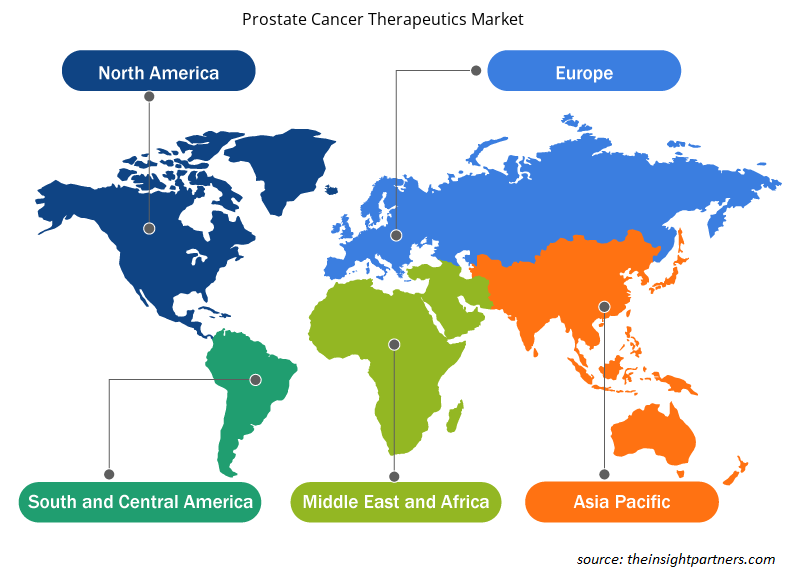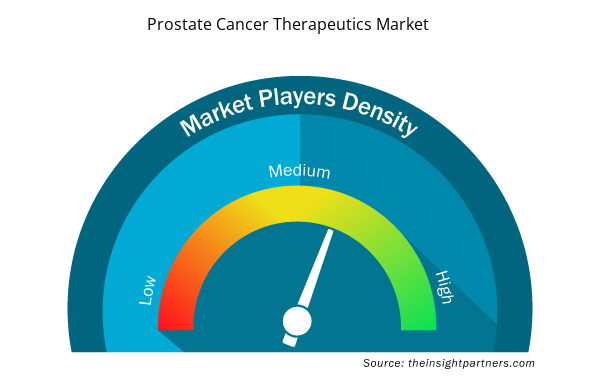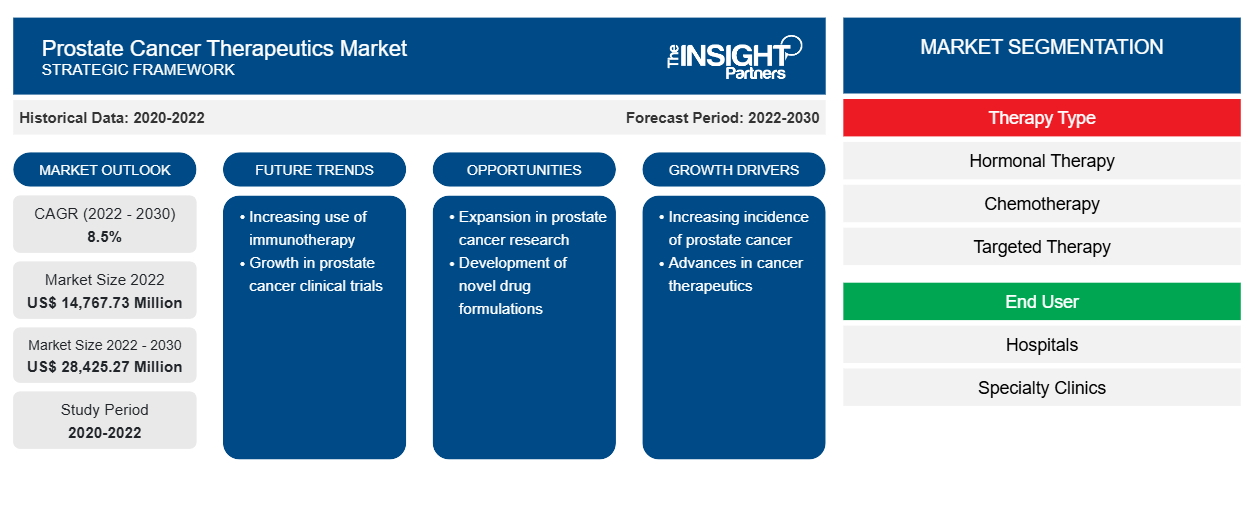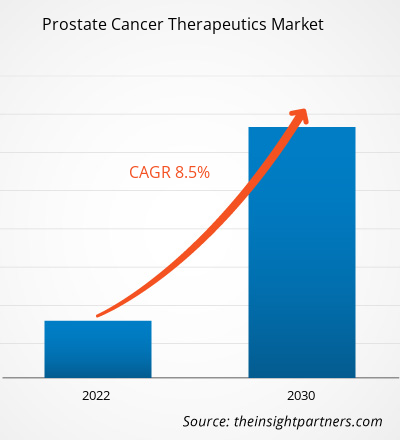[Informe de investigación] Se espera que el mercado de terapias contra el cáncer de próstata crezca de US$ 14.767,73 millones en 2022 a US$ 28.425,27 millones en 2030; se anticipa que registre una CAGR del 8,5% entre 2022 y 2030.
Perspectivas del mercado y opinión de analistas:
El tamaño del mercado de terapias contra el cáncer de próstata se está expandiendo con el aumento de las actividades de I+D para introducir nuevos compuestos farmacológicos, el aumento del número de casos de cáncer de próstata y el aumento del apoyo gubernamental para el diagnóstico del cáncer de próstata. Además, la disponibilidad de productos avanzados por parte de los actores del mercado impulsa el crecimiento del mercado. En enero de 2023, BDR Pharmaceutical lanzó una versión genérica de Apalutamide que se utiliza para tratar el cáncer de próstata en la India. El medicamento se lanza bajo la marca APATIDE y se prescribe para tratar el cáncer de próstata resistente a la castración no metastásico y el cáncer de próstata sensible a la castración metastásico.
Factores impulsores del crecimiento y desafíos:
El cáncer de próstata es uno de los problemas de salud más comunes en los hombres, especialmente en los hombres mayores de 50 años. El cáncer de próstata es más común en hombres obesos y con antecedentes familiares de cáncer de próstata. El cáncer de próstata es una amenaza silenciosa, ya que a menudo se desarrolla sin síntomas perceptibles. Por lo tanto, la detección temprana de este cáncer no es tan fácil. La mayoría de los cánceres de próstata se originan en la región periférica de la glándula prostática. Para que los síntomas se vuelvan evidentes, el cáncer debe alcanzar un tamaño tal que ejerza presión sobre la uretra, o el dolor óseo debido a la metástasis podría ser el síntoma inicial de presentación de cáncer de próstata avanzado en algunos casos. Sin embargo, cualquier persona de 50 años o más que presente síntomas del tracto urinario inferior, disfunción eréctil o hematuria debe considerar la posibilidad de cáncer de próstata. El cáncer de próstata es la quinta causa principal de muerte por cáncer entre los hombres en todo el mundo y el segundo cáncer más comúnmente diagnosticado. Aunque la incidencia del cáncer de próstata ha disminuido desde el año 2000, la incidencia del cáncer de próstata en etapa avanzada ha aumentado a partir de 2010. Las tasas de incidencia y mortalidad del cáncer de próstata difieren enormemente. Los países desarrollados suelen tener una mayor incidencia de cáncer de próstata, pero una menor mortalidad. El riesgo de cáncer de próstata en los EE. UU. es casi cuatro veces mayor que el riesgo global. Según Novartis AG, en 2020 se notificaron alrededor de 1,4 millones de nuevos casos de cáncer de próstata y alrededor de 375 000 muertes por cáncer de próstata en todo el mundo. El creciente número de casos de cáncer de próstata en todo el mundo y la baja tasa de detección del cáncer de próstata impulsan el crecimiento del mercado de terapias para el cáncer de próstata.
Personalice este informe según sus necesidades
Obtendrá personalización en cualquier informe, sin cargo, incluidas partes de este informe o análisis a nivel de país, paquete de datos de Excel, así como también grandes ofertas y descuentos para empresas emergentes y universidades.
- Obtenga las principales tendencias clave del mercado de este informe.Esta muestra GRATUITA incluirá análisis de datos, desde tendencias del mercado hasta estimaciones y pronósticos.
Segmentación y alcance del informe:
El mercado de terapias para el cáncer de próstata está segmentado en función del tipo de terapia, el usuario final y la geografía. El mercado de terapias para el cáncer de próstata, por tipo de terapia, está segmentado en terapia hormonal, quimioterapia, inmunoterapia, terapia dirigida y otras. El mercado de terapias para el cáncer de próstata, por usuario final, está segmentado en hospitales, clínicas especializadas y otros. Según la geografía, el mercado de terapias para el cáncer de próstata está segmentado en América del Norte (EE. UU., Canadá y México), Europa (Reino Unido, Alemania, Francia, Italia, España y el resto de Europa), Asia Pacífico (China, Japón, India, Corea del Sur, Australia y el resto de Asia Pacífico), Oriente Medio y África (EAU, Arabia Saudita, Sudáfrica y el resto de Oriente Medio y África) y América del Sur y Central (Brasil, Argentina y el resto de América del Sur y Central).
Análisis segmental:
El mercado de terapias contra el cáncer de próstata, por tipo de terapia, está segmentado en terapia hormonal, quimioterapia, inmunoterapia, terapia dirigida y otras. En 2022, el segmento de terapia hormonal tuvo la mayor participación de mercado después de la quimioterapia, y se espera que el mismo segmento registre la CAGR más alta entre 2022 y 2030. La quimioterapia se considera un tratamiento importante para el cáncer de próstata. En esta terapia, los medicamentos destruyen las células cancerosas nuevas o existentes en los pulmones. La quimioterapia para el cáncer de próstata metastásico puede aliviar los síntomas. También puede ayudar a reducir el cáncer y mejorar la calidad de vida. El docetaxel (Taxotere) se considera el estándar de atención en la quimioterapia del cáncer de próstata en pacientes resistentes a la terapia hormonal. La FDA también aprobó el fármaco de quimioterapia cabazitaxel (Jevtana) para tratar el cáncer de próstata resistente a la castración. También se utiliza para pacientes afectados por cáncer de próstata metastásico que ha crecido mientras tomaban docetaxel.
Análisis regional:
El mercado de terapias para el cáncer de próstata está segmentado geográficamente en América del Norte, Europa, Asia Pacífico, Oriente Medio y África, y América del Sur y Central. América del Norte es el mayor contribuyente al crecimiento del mercado mundial de terapias para el cáncer de próstata. Se espera que Asia Pacífico registre la CAGR más alta en el mercado de terapias para el cáncer de próstata entre 2022 y 2030. El crecimiento del mercado de terapias para el cáncer de próstata en los EE. UU. está impulsado principalmente por la creciente incidencia de casos de cáncer de próstata, lanzamientos de productos e iniciativas gubernamentales. En junio de 2023, Lynparza (olaparib) de AstraZeneca y MSD en combinación con prednisona o prednisolona y abiraterona fue aprobado en los EE. UU. para tratar a pacientes adultos con sospecha de cáncer de próstata metastásico resistente a la castración (mCRPC) con mutación BRCA (BRCAm) deletérea. Además, en noviembre de 2023, la FDA aprobó la enzalutamida, un producto que fabrica Astellas Pharma US, Inc. El producto se utiliza para el tratamiento del cáncer de próstata sensible a la castración no metastásico (nmCSPC) con recurrencia bioquímica con alto riesgo de metástasis (BCR de alto riesgo).
Perspectivas regionales del mercado de terapias contra el cáncer de próstata
Los analistas de Insight Partners explicaron en detalle las tendencias y los factores regionales que influyen en el mercado de terapias contra el cáncer de próstata durante el período de pronóstico. Esta sección también analiza los segmentos y la geografía del mercado de terapias contra el cáncer de próstata en América del Norte, Europa, Asia Pacífico, Oriente Medio y África, y América del Sur y Central.

- Obtenga datos regionales específicos para el mercado de terapias contra el cáncer de próstata
Alcance del informe sobre el mercado de terapias contra el cáncer de próstata
| Atributo del informe | Detalles |
|---|---|
| Tamaño del mercado en 2022 | US$ 14.767,73 millones |
| Tamaño del mercado en 2030 | US$ 28.425,27 millones |
| CAGR global (2022-2030) | 8,5% |
| Datos históricos | 2020-2022 |
| Período de pronóstico | 2022-2030 |
| Segmentos cubiertos | Por tipo de terapia
|
| Regiones y países cubiertos | América del norte
|
| Líderes del mercado y perfiles de empresas clave |
|
Densidad de actores del mercado: comprensión de su impacto en la dinámica empresarial
El mercado de productos terapéuticos para el cáncer de próstata está creciendo rápidamente, impulsado por la creciente demanda de los usuarios finales debido a factores como la evolución de las preferencias de los consumidores, los avances tecnológicos y una mayor conciencia de los beneficios del producto. A medida que aumenta la demanda, las empresas amplían sus ofertas, innovan para satisfacer las necesidades de los consumidores y aprovechan las tendencias emergentes, lo que impulsa aún más el crecimiento del mercado.
La densidad de actores del mercado se refiere a la distribución de las empresas o firmas que operan dentro de un mercado o industria en particular. Indica cuántos competidores (actores del mercado) están presentes en un espacio de mercado determinado en relación con su tamaño o valor total de mercado.
Las principales empresas que operan en el mercado de terapias contra el cáncer de próstata son:
- Astella Pharma Inc
- Servicios de Johnson & Johnson Inc.
- Eli Lilly y compañía
- Bayer AG
- Sanofi
Descargo de responsabilidad : Las empresas enumeradas anteriormente no están clasificadas en ningún orden particular.

- Obtenga una descripción general de los principales actores clave del mercado de terapias contra el cáncer de próstata
Desarrollos industriales y oportunidades futuras:
A continuación se enumeran varias iniciativas de actores clave que operan en el mercado de terapias contra el cáncer de próstata:
- En marzo de 2022, la FDA de EE. UU. aprobó Pluvicto de Novartis (lutecio Lu 177 vipivotide tetraxetan) para el tratamiento de pacientes adultos con un tipo de cáncer de próstata avanzado llamado cáncer de próstata metastásico resistente a la castración con antígeno de membrana específico de la próstata positivo (mCRPC positivo para PSMA).
- En abril de 2023, la FDA otorgó a Lantheus Holdings Inc y POINT Biopharma Global Inc la designación de vía rápida para 177Lu-PNT2002 para el tratamiento del cáncer de próstata metastásico resistente a la castración (mCRPC). PNT2002 es una innovadora terapia radiofarmacéutica basada en 177Lu dirigida al PSMA que combina un ligando dirigido al PSMA, PSMA-I&T y 177Lu, un radioisótopo emisor de beta sin portador añadido para el tratamiento del mCRPC.
Panorama competitivo y empresas clave:
Astella Pharma Inc, Johnson & Johnson Services Inc, Eli Lilly and Company, Bayer AG, Sanofi, Merck KGaA, AstraZeneca, Novartis AG, AbbVie y Bristol Myers Squibb se encuentran entre los actores destacados que operan en el mercado de terapias contra el cáncer de próstata. Estos actores del mercado se centran en lanzamientos de nuevos productos y expansiones geográficas para satisfacer la creciente demanda de los consumidores en todo el mundo y aumentar su gama de productos en carteras especializadas. Su presencia global les permite atender a una gran base de clientes, lo que facilita posteriormente la expansión del mercado.
- Análisis histórico (2 años), año base, pronóstico (7 años) con CAGR
- Análisis PEST y FODA
- Tamaño del mercado Valor/volumen: global, regional, nacional
- Industria y panorama competitivo
- Conjunto de datos de Excel


- Vision Guided Robotics Software Market
- Intraoperative Neuromonitoring Market
- Dropshipping Market
- E-Bike Market
- Machine Condition Monitoring Market
- Foot Orthotic Insoles Market
- Nuclear Decommissioning Services Market
- Bio-Based Ethylene Market
- Fish Protein Hydrolysate Market
- Genetic Testing Services Market

Report Coverage
Revenue forecast, Company Analysis, Industry landscape, Growth factors, and Trends

Segment Covered
This text is related
to segments covered.

Regional Scope
North America, Europe, Asia Pacific, Middle East & Africa, South & Central America

Country Scope
This text is related
to country scope.
Preguntas frecuentes
Based on geography, the prostate cancer therapeutics market is segmented into North America (the US, Canada, and Mexico), Europe (the UK, Germany, France, Italy, Spain, and the Rest of Europe), Asia Pacific (China, Japan, India, South Korea, Australia, and the Rest of Asia Pacific), the Middle East & Africa (the UAE, Saudi Arabia, South Africa, and Rest of the Middle East & Africa), and South & Central America (Brazil, Argentina, and the Rest of South & Central America). North America is the largest contributor to global prostate cancer therapeutics market growth. Asia Pacific is expected to register the highest CAGR in the prostate cancer therapeutics market from 2022 to 2030.
The prostate cancer therapeutics market, by therapy type, is segmented into hormone therapy, chemotherapy, immunotherapy, targeted therapy, and others. In 2022, the chemotherapy segment held the largest market share, and the same segment is expected to record the highest CAGR from 2022 to 2030.
The prostate cancer therapeutics market, by end-user, is segmented into hospitals, specialty clinics, and others. In 2022, the hospital segment held the largest market share; moreover, the same segment is expected to record the highest CAGR during 2022–2030.
The increasing cases of prostate cancer and strategic initiatives in prostate cancer therapeutics freezer bolster the prostate cancer therapeutics market size. However, the high cost associated with prostate cancer therapeutics hinders the growth of prostate cancer therapeutics market growth.
The prostate cancer therapeutics market majorly consists of players such Astella Pharma Inc, Johnson & Johnson Services Inc, Eli Lilly and Company, Bayer AG, Sanofi, Merck KGaA, AstraZeneca, Novartis AG, AbbVie, and Bristol Myers Squibb
Prostate cancer is one of the most common health problems in men, especially in older men (aged above 50 years). Prostate cancer is mostly common in men who are obese and have a family history of prostate cancer. Prostate cancer is a silent threat that often develops without noticeable symptoms, and hence, early detection of this cancer is not that easy. Typically, the majority of prostate cancers originate in the peripheral region of the prostate gland. Consequently, for symptoms to become apparent, the cancer must reach a size where it exerts pressure on the urethra, or in some cases, bone pain from the metastasis might be the initial presenting symptom of advanced prostate cancer. However, any individual aged 50 or above who presents with lower urinary tract symptoms, erectile dysfunction, or hematuria should consider the possibility of prostate cancer.
Trends and growth analysis reports related to Life Sciences : READ MORE..
The List of Companies - Prostate Cancer Market
- Astella Pharma Inc
- Johnson & Johnson Services Inc
- Eli Lilly, and Company
- Bayer AG
- Sanofi
- Merck KGaA
- AstraZeneca
- Novartis AG
- AbbVie
- Bristol Myers Squibb
The Insight Partners performs research in 4 major stages: Data Collection & Secondary Research, Primary Research, Data Analysis and Data Triangulation & Final Review.
- Data Collection and Secondary Research:
As a market research and consulting firm operating from a decade, we have published and advised several client across the globe. First step for any study will start with an assessment of currently available data and insights from existing reports. Further, historical and current market information is collected from Investor Presentations, Annual Reports, SEC Filings, etc., and other information related to company’s performance and market positioning are gathered from Paid Databases (Factiva, Hoovers, and Reuters) and various other publications available in public domain.
Several associations trade associates, technical forums, institutes, societies and organization are accessed to gain technical as well as market related insights through their publications such as research papers, blogs and press releases related to the studies are referred to get cues about the market. Further, white papers, journals, magazines, and other news articles published in last 3 years are scrutinized and analyzed to understand the current market trends.
- Primary Research:
The primarily interview analysis comprise of data obtained from industry participants interview and answers to survey questions gathered by in-house primary team.
For primary research, interviews are conducted with industry experts/CEOs/Marketing Managers/VPs/Subject Matter Experts from both demand and supply side to get a 360-degree view of the market. The primary team conducts several interviews based on the complexity of the markets to understand the various market trends and dynamics which makes research more credible and precise.
A typical research interview fulfils the following functions:
- Provides first-hand information on the market size, market trends, growth trends, competitive landscape, and outlook
- Validates and strengthens in-house secondary research findings
- Develops the analysis team’s expertise and market understanding
Primary research involves email interactions and telephone interviews for each market, category, segment, and sub-segment across geographies. The participants who typically take part in such a process include, but are not limited to:
- Industry participants: VPs, business development managers, market intelligence managers and national sales managers
- Outside experts: Valuation experts, research analysts and key opinion leaders specializing in the electronics and semiconductor industry.
Below is the breakup of our primary respondents by company, designation, and region:

Once we receive the confirmation from primary research sources or primary respondents, we finalize the base year market estimation and forecast the data as per the macroeconomic and microeconomic factors assessed during data collection.
- Data Analysis:
Once data is validated through both secondary as well as primary respondents, we finalize the market estimations by hypothesis formulation and factor analysis at regional and country level.
- Macro-Economic Factor Analysis:
We analyse macroeconomic indicators such the gross domestic product (GDP), increase in the demand for goods and services across industries, technological advancement, regional economic growth, governmental policies, the influence of COVID-19, PEST analysis, and other aspects. This analysis aids in setting benchmarks for various nations/regions and approximating market splits. Additionally, the general trend of the aforementioned components aid in determining the market's development possibilities.
- Country Level Data:
Various factors that are especially aligned to the country are taken into account to determine the market size for a certain area and country, including the presence of vendors, such as headquarters and offices, the country's GDP, demand patterns, and industry growth. To comprehend the market dynamics for the nation, a number of growth variables, inhibitors, application areas, and current market trends are researched. The aforementioned elements aid in determining the country's overall market's growth potential.
- Company Profile:
The “Table of Contents” is formulated by listing and analyzing more than 25 - 30 companies operating in the market ecosystem across geographies. However, we profile only 10 companies as a standard practice in our syndicate reports. These 10 companies comprise leading, emerging, and regional players. Nonetheless, our analysis is not restricted to the 10 listed companies, we also analyze other companies present in the market to develop a holistic view and understand the prevailing trends. The “Company Profiles” section in the report covers key facts, business description, products & services, financial information, SWOT analysis, and key developments. The financial information presented is extracted from the annual reports and official documents of the publicly listed companies. Upon collecting the information for the sections of respective companies, we verify them via various primary sources and then compile the data in respective company profiles. The company level information helps us in deriving the base number as well as in forecasting the market size.
- Developing Base Number:
Aggregation of sales statistics (2020-2022) and macro-economic factor, and other secondary and primary research insights are utilized to arrive at base number and related market shares for 2022. The data gaps are identified in this step and relevant market data is analyzed, collected from paid primary interviews or databases. On finalizing the base year market size, forecasts are developed on the basis of macro-economic, industry and market growth factors and company level analysis.
- Data Triangulation and Final Review:
The market findings and base year market size calculations are validated from supply as well as demand side. Demand side validations are based on macro-economic factor analysis and benchmarks for respective regions and countries. In case of supply side validations, revenues of major companies are estimated (in case not available) based on industry benchmark, approximate number of employees, product portfolio, and primary interviews revenues are gathered. Further revenue from target product/service segment is assessed to avoid overshooting of market statistics. In case of heavy deviations between supply and demand side values, all thes steps are repeated to achieve synchronization.
We follow an iterative model, wherein we share our research findings with Subject Matter Experts (SME’s) and Key Opinion Leaders (KOLs) until consensus view of the market is not formulated – this model negates any drastic deviation in the opinions of experts. Only validated and universally acceptable research findings are quoted in our reports.
We have important check points that we use to validate our research findings – which we call – data triangulation, where we validate the information, we generate from secondary sources with primary interviews and then we re-validate with our internal data bases and Subject matter experts. This comprehensive model enables us to deliver high quality, reliable data in shortest possible time.


 Obtenga una muestra gratuita de este informe
Obtenga una muestra gratuita de este informe